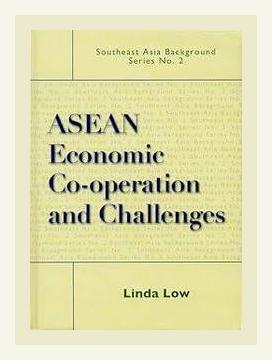Business Law and EthicsInternational Trade Law
Introduction
Linda Low’s ASEAN Economic Co-operation and Challenges (2009) is an extensive examination of the economic, legal, and policy frameworks that shape the Association of Southeast Asian Nations (ASEAN). The book delves into the intricacies of ASEAN’s economic cooperation, the challenges it faces, and the potential it holds in fostering regional integration and global competitiveness. This summary provides an overview of the key points discussed in the book, supported by concrete examples and actionable advice.
Chapter 1: Evolution of ASEAN Economic Cooperation
Major Points
- Historical Background and Objectives:
- ASEAN was established in 1967 to promote regional stability and economic growth.
- Key objectives include accelerating economic growth, social progress, cultural development, and maintaining peace and stability.
Examples and Actions:
- Example: The Bangkok Declaration of 1967 is highlighted as the founding document that sets the stage for regional cooperation.
- Action: For policymakers, it’s crucial to revisit foundational documents like the Bangkok Declaration to understand the original intent and objectives, and to ensure current policies align with these goals.
Chapter 2: Legal Framework and Institutions
Major Points
- Institutional Mechanisms:
- ASEAN operates through a robust institutional framework including the ASEAN Secretariat and various ministerial councils.
- The ASEAN Charter, ratified in 2008, provides a legal status and institutional framework for ASEAN.
Examples and Actions:
- Example: The establishment of the ASEAN Economic Community (AEC) as a pillar of cooperation.
- Action: Businesses should familiarize themselves with the AEC blueprint to align their strategies with ASEAN’s integration goals and leverage the unified market.
Chapter 3: Economic Integration Efforts
Major Points
- ASEAN Free Trade Area (AFTA):
- Established to eliminate tariff and non-tariff barriers among member countries.
- Facilitates easier market access and boosts intra-regional trade.
Examples and Actions:
- Example: Tariff reductions under the Common Effective Preferential Tariff (CEPT) scheme.
- Action: Exporters within ASEAN should identify which products benefit from reduced tariffs and adjust their pricing strategies accordingly.
Chapter 4: Investment Frameworks
Major Points
- ASEAN Investment Area (AIA):
- Promotes a free and open investment regime to attract both intra-ASEAN and external investments.
- Ensures non-discriminatory treatment of investors and the protection of investment.
Examples and Actions:
- Example: The implementation of the ASEAN Comprehensive Investment Agreement (ACIA) in 2012, which builds on the AIA.
- Action: Investors should take advantage of the protections and benefits offered by ACIA to mitigate risk and enhance returns in ASEAN markets.
Chapter 5: Challenges to Integration
Major Points
- Economic Disparities:
- Significant developmental and economic disparities exist between more developed members like Singapore and those like Myanmar and Laos.
Examples and Actions:
- Example: Different levels of industrialization and urbanization across member states.
- Action: Development agencies should design tailored interventions that address specific developmental challenges in less developed ASEAN countries.
Chapter 6: External Economic Relations
Major Points
- ASEAN Plus Frameworks:
- ASEAN engages with external partners through the “ASEAN Plus” frameworks, including ASEAN Plus Three (China, Japan, and South Korea) and ASEAN Plus Six (including Australia, New Zealand, and India).
Examples and Actions:
- Example: The Regional Comprehensive Economic Partnership (RCEP) initiated under the ASEAN Plus framework.
- Action: Trade negotiators should leverage ASEAN’s existing partnerships to foster broader economic integration and market access within the RCEP framework.
Chapter 7: Policy Harmonization
Major Points
- Standards and Mutual Recognition Arrangements (MRAs):
- Efforts to harmonize standards and regulations to facilitate smoother trade and investment flows within the region.
Examples and Actions:
- Example: ASEAN’s various MRAs in sectors such as electrical and electronic equipment, and cosmetics.
- Action: Companies should ensure their products comply with ASEAN’s MRAs to benefit from streamlined entry into multiple ASEAN markets.
Chapter 8: Financial Integration
Major Points
- ASEAN Banking Integration Framework (ABIF):
- Facilitates greater financial integration and stability within the region.
- Promotes cross-border banking and financial services.
Examples and Actions:
- Example: Bilateral banking arrangements and regulatory harmonization initiatives under ABIF.
- Action: Financial institutions should explore opportunities for cross-border operations and partnerships within ASEAN, utilizing ABIF guidelines.
Chapter 9: Sustainable Development
Major Points
- Green Growth and Environmental Cooperation:
- Integration of sustainable development and environmental protection into ASEAN’s economic cooperation frameworks.
- Initiatives to foster green growth and renewable energy adoption.
Examples and Actions:
- Example: ASEAN Action Plan on Joint Response to Climate Change.
- Action: Businesses and policymakers should align their sustainability goals with ASEAN’s environmental initiatives, promoting green technologies and practices.
Chapter 10: Future Directions and Strategic Recommendations
Major Points
- Vision for ASEAN 2025:
- ASEAN aims to become a more integrated, cohesive, and citizen-centered community by 2025.
- Strategic measures to enhance regional connectivity, strengthen institutional capacity, and promote equitable economic development.
Examples and Actions:
- Example: Plans to enhance digital connectivity and infrastructural investments under the Master Plan on ASEAN Connectivity (MPAC) 2025.
- Action: Companies should invest in digital technologies and infrastructure projects that align with ASEAN’s 2025 vision to capture emerging opportunities.
Conclusion
Linda Low’s ASEAN Economic Co-operation and Challenges provides a comprehensive overview of ASEAN’s economic integration and cooperation efforts. By examining historical contexts, legal frameworks, investment dynamics, policy harmonization, and sustainability measures, Low provides valuable insights into the challenges and opportunities within ASEAN. For practitioners, whether policymakers, business leaders, or investors, understanding these multifaceted dynamics can facilitate better decision-making and strategic planning, thereby leveraging ASEAN’s aspirations for a more integrated and prosperous regional community.
